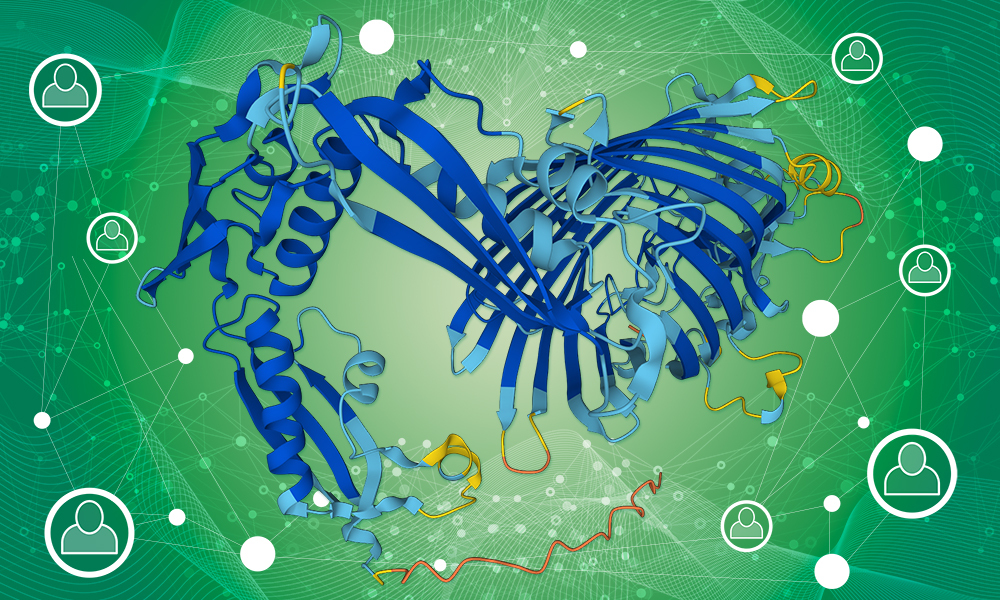A structural biology community assessment of AlphaFold2 applications
Nature Structural and Molecular Biology 7 November 2022
10.1038/s41594-022-00849-w
Researchers use social media to share findings on how useful AlphaFold predictions are for different applications

In the era of social media, researchers studying similar topics can work together despite being based in different parts of the world. Social platforms have become a tool for scientific collaboration, including testing the validity of new methods and technologies, such as the AlphaFold AI system for predicting protein structures.
A paper published in Nature Structural and Molecular Biology has brought together results from a number of groups who, when the AlphaFold code and protein structure predictions were first made public, coordinated their efforts through social media to evaluate the use of the predictions in a range of applications.
“After the AlphaFold launch, there was so much buzz in the structural biology world about what this was going to mean for our day to day work,” explained Pedro Beltrao, Associate Professor at ETH and former Group Leader at EMBL-EBI. “Lots of people were sharing initial results and excitement on social media, exploring the method and the predictions. I contacted several of them to see if they were interested in a joint study rounding up all the results that were being shared left and right on social media.”
Beltrao found that there was a lot of interest in his idea. “It picked up speed very quickly. At one point I was even receiving results on social media and, bit by bit, this paper got built up from social media interactions. It was a real bottom-up approach, building on the excitement of the initial results.
Beltrao mentioned seeing a similar thing with COVID – scientists who had never met before, based in different corners of the world, working together to uncover insights about the virus. On this occasion, the trigger wasn’t a health crisis, it was an exciting new discovery.
“I think this really illustrates a new way of doing science. It’s like maximising the capacity of everyone and bringing everything together while trying to avoid duplication of efforts. And personally I see a lot of value in this, it’s an exciting way to work.”
There is a whole world of applications for protein structure predictions. But when EMBL-EBI and DeepMind made the first batch of 350,000 AlphaFold predictions openly available to the scientific community through the AlphaFold Database in the summer of 2021, researchers had many unanswered questions about how accurate and useful the predictions would be.
In the end, this paper brought together researchers from 18 institutes in 11 countries. They pooled their results evaluating the use of AlphaFold predictions in the following areas:
After much excitement, hundreds of hours of work, and complex timezone negotiations, the results came in. “For the applications we explored, AlphaFold predictions were as good as experimental structures, as long as you critically consider the confidence metrics,” said Beltrao.
“We were already in the process of testing how well our modelling methods worked on the AlphaFold structures when we heard about Pedro’s initiative and were excited to contribute,” said Amelie Stein, Assistant Professor, University of Copenhagen. “It’s such a fast-moving field right now and we were happy to join the collaborative effort so that others could read about and benefit from our findings.”
“The sudden leap in the numbers of high quality predicted structures got us very excited to hunt for patterns in predicted and experimental structures,” added Janani Durairaj, a postdoc at the University of Basel. “Thanks to this wonderful collaborative effort, we could both share our findings with the community and see all the different perspectives from which such comparisons could be made.”
Since this paper was published as a preprint, the AlphaFold Database has now grown to include predictions for over 200 million proteins, from one million species. These are the vast majority of catalogued proteins which have sequences available in UniProt.
Full funding information is available in the paper.
Nature Structural and Molecular Biology 7 November 2022
10.1038/s41594-022-00849-w